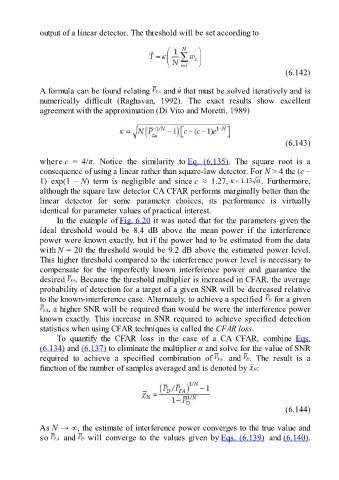Page 507 - Fundamentals of Radar Signal Processing
P. 507
output of a linear detector. The threshold will be set according to
(6.142)
A formula can be found relating and that must be solved iteratively and is
numerically difficult (Raghavan, 1992). The exact results show excellent
agreement with the approximation (Di Vito and Moretti, 1989)
(6.143)
where c = 4/π. Notice the similarity to Eq. (6.135). The square root is a
consequence of using a linear rather than square-law detector. For N > 4 the (c –
1) exp(1 – N) term is negligible and since c ≈ 1.27, . Furthermore,
although the square law detector CA CFAR performs marginally better than the
linear detector for some parameter choices, its performance is virtually
identical for parameter values of practical interest.
In the example of Fig. 6.20 it was noted that for the parameters given the
ideal threshold would be 8.4 dB above the mean power if the interference
power were known exactly, but if the power had to be estimated from the data
with N = 20 the threshold would be 9.2 dB above the estimated power level.
This higher threshold compared to the interference power level is necessary to
compensate for the imperfectly known interference power and guarantee the
desired . Because the threshold multiplier is increased in CFAR, the average
probability of detection for a target of a given SNR will be decreased relative
to the known-interference case. Alternately, to achieve a specified for a given
, a higher SNR will be required than would be were the interference power
known exactly. This increase in SNR required to achieve specified detection
statistics when using CFAR techniques is called the CFAR loss.
To quantify the CFAR loss in the case of a CA CFAR, combine Eqs.
(6.134) and (6.137) to eliminate the multiplier α and solve for the value of SNR
required to achieve a specified combination of and . The result is a
function of the number of samples averaged and is denoted by :
(6.144)
As N → ∞, the estimate of interference power converges to the true value and
so and will converge to the values given by Eqs. (6.139) and (6.140).

